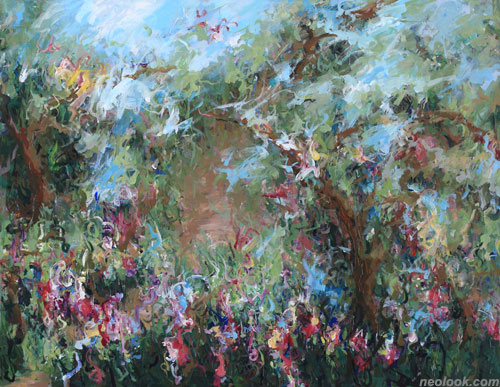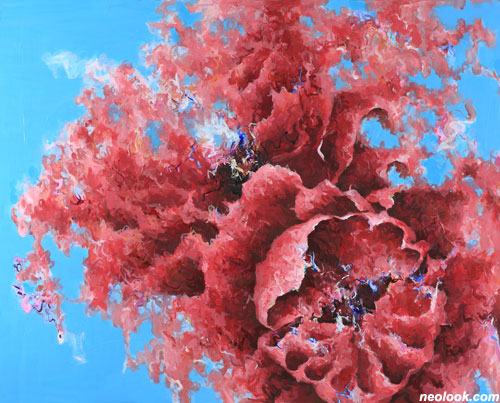- ● homepage
- ● archives
- ● restoration
- ● books
- ● big banners
- ● post board
- ■ neo's search
- ■ about us
- ■ 게재방법 안내
- 개인정보처리방침

- [email protected]
- Tel. 02_335_7922
- Fax. 02_335_7929
- 10:00am~04:30pm
- 월요일~금요일
- 3/3(월) 대체공휴일

몽환정원도(夢幻庭園圖, Visionary Garden)
김양희展 / KIMYANGHEE / 金良姬 / painting 2010_1117 ▶ 2010_1130 / 공휴일 휴관
● 위 이미지를 클릭하면 네오룩 아카이브 Vol.20100507a | 김양희展으로 갑니다.
초대일시_2010_1117_수요일_06:00pm
관람시간 / 09:00am~08:00pm / 토요일_10:00am~03:00pm / 공휴일 휴관
포스코미술관_POSCO ART MUSEUM 서울 강남구 대치4동 892번지 포스코센터 서관 2층 Tel. +82.2.3457.1665 www.poscoartmuseum.org
기억으로부터 발생하여 상상으로 피어나는 꽃 ● 사람은 기억력을 가지고 있다. 따라서 개인마다 차이는 있겠지만 사람들은 언젠가 한번 만난 대상에 대해서 일정한 시간동안 기억한다. 만약에 만남의 횟수가 반복된다면 기억은 그만큼 선명해질 수 있다. 그리고 눈을 감아도 그 대상을 마치 눈앞에 나타난 것처럼 생생하게 떠올릴 수도 있다. 이와 반대로 오래 전에 만났던 대상에 대해서는 그것의 일부분만이 기억나거나 전체적으로 불분명한 기억 속에 그 대상으로부터 받았던 인상(impression)이 어떠한 상황이나 사물과 연계되어 상상과 함께 현실에서 편집된 상태로 되살아나는 경우가 종종 있다. ● 김양희가 그리는 꽃은 작가의 기억 속에서 되살아나오는 어린 시절에서부터 기인한다. 어린 시절의 생활 주변에서 반복적으로 맡았던 꽃의 향기가 작가의 기억 속에 깊이 각인되어 수 십 년 뒤에까지 그것을 기억하게 만들었고 작품 속의 이미지로 환생하게 만들었다. 꽃은 시각으로만 기억되지 않고 후각이나 촉각 등으로도 기억된다. 그러나 김양희의 어린 시절의 꽃들은 시간의 경과에 비례하여 그 자체의 모습에 대한 사실주의적 선명도를 점차 잃어가고 있으며 그렇게 잃게 된 선명도의 빈자리를 작가의 상상력이 대신 메워가고 있다. 따라서 김양희의 꽃은 기억으로부터 발생하여 상상으로 마무리되는, 작가의 주관적인 감각의 경험과 의식을 드러내는 꽃인 것이다.

- 김양희_obsession_캔버스에 아크릴채색_91×117cm_2010
김양희는 자신이 화면에 도입하는 꽃들에게서 추억과 함께 물활론(物活論)적 정서를 느낀다. 그러므로 작가가 자신의 작품 속에서 시각화해내는 꽃은 우리의 공통정서에 자리 잡은 평범한 꽃의 실재이고 그것이 시각적으로 구현된 이미지이면서 동시에 그것을 넘어서는 생명이며 에너지인 것이다. 코발트 색을 배경으로 한 화면에 가득히 담겨진 주황색 양귀비꽃은 사실적 재현성에 집중하기 보다는 한편으로는 마치 인간이나 동물처럼 살아있는 식물로서의 생명감과 정신적 존재감을 발산하며, 다른 한 편으로는 이를 바라보는 이들의 정신세계에 침투하여 몽환적인 상상계로 빠져들게 만드는 묘한 매력을 드러낸다. ● 김양희의 꽃을 자세히 살펴보면 일반적으로 꽃이라는 식물에서 드러나는 아름다움이나 향기, 부드러움이나 화려함 같은 표현이 정확하게 어울리기 힘든 치명적인, 그러나 그로부터 쉽게 벗어나기 힘든 환상과 같은 자태를 발견할 수 있다. 우리 눈에 보이지 않는 모종의 액체에 잠긴 듯 허공에서 둥둥 떠오르는 것처럼 보이는 꽃은 잎의 테두리부분에서 점점 녹아내리듯이 허공으로 해체되면서 꽃으로서의 자아의 존재를 새로운 그 무엇인가로 전이시키려는 것 같은 모습을 보여준다. 이처럼 김양희의 꽃은 마치 깊이를 알 수 없는 어떤 곳으로부터 작용하는 일종의 충동이 에너지를 발산하듯 꽃잎을 화면에 가득 차게 만드는 모습으로 제시된다. ● 김양희 본인의 말에 따르면 작가는 인간을 포함한 사물은 태생적 한계를 극복하고 보다 높은 단계를 향해 현실을 초월하려는 본능적 욕구를 억제할 수 없으며, 이러한 욕구 혹은 염원을 욕망이라는 부정적인 시선으로 바라보기보다는 우리가 살고 있는 현대사회에서의 적극적인 자가 실현 욕구의 가시화이며 종의 진화를 염원하는 노력이라는 시각으로 바라볼 수도 있다는 것이다.

- 김양희_obsession_캔버스에 아크릴채색_91×117cm_2010

- 김양희_obsession11_혼합재료_130×162cm_2010

- 김양희_obsession5_혼합재료_91×117cm_2010
형식적인 측면에서 볼 때 김양희의 작품에서 꽃의 형태는 점차 해체되어 점점 추상화되는 과정을 거친다. 붉은 꽃의 잎들은 또 다른 생명체의 해체과정을 보여주는 것처럼 실타래가 풀리듯 가장자리 부분에서부터 허물어져가고 꽃술 역시 꽃잎의 중앙 깊은 곳으로부터 그림의 표면으로 부유하듯 솟아오르며 한 올 한 올 해체되는 듯한 모습을 보여준다. 결국 이러한 형태의 해체과정은 다음 단계로 이어지는 형태의 해체와 색채의 단순화를 예고해주는 것이라고 할 수 있다. ● 청보라색 꽃들이 전개되는 화면의 단계에 이르면 김양희의 작품은 이미 재현의 단계를 지나 추상의 단계로 들어서며 색채 또한 모노톤에 가깝게 비사실적이며 상징적으로 전환된다. 이러한 전환은 작가의 작품 전체를 조망할 때 지극히 자연스런 맥락상의 전환으로 받아들일 수 있으며 색과 선, 표면 질감 등의 형식주의적 요소들의 일관성을 통해 작품의 전이를 정당화시켜주는 면이 있다. 화면의 전반적인 모노톤에 비하여 명암의 강조나 붓의 스트로크가 만들어내는 생명감이 오히려 화면을 생기 있게 만들어주면서 작품은 점점 신비스런 환상의 심연으로 빨려들어가듯 관람자들의 시각을 자극한다.

- 김양희_obsession6_혼합재료_162×112cm_2010
평면 작품과 함께 출품된 설치작품들은 작가가 이전부터 천착해 온 obsession이라는 주제를 담은 연작으로서 인간을 사로잡는 욕망과 집착의 조형적 표현이라기보다는 이러한 충동을 넘어서 존재의 태생적 한계를 극복, 초월하려는 의지를 가시화한 입체물의 설치로서 해석될 수 있다. 이 작품에서도 역시 작가는 꽃으로 인식되는 이미지를 유지하며 재료에 있어서 한지를 사용함으로써 주제면에 있어서는 일관성을 유지하면서도 표현 형식에 있어서 평면과는 다른 확장된 조형적 시도를 모색하고 있다는 것을 짐작하게 해준다. ● 이처럼 김양희는 오래 동안 꽃이라는 식물의 생명성과 그것에 투영된 존재의 숙명, 그리고 그 존재의 숙명을 초월하려는 염원을 시각화하는 작업에 작가의 에너지를 바쳐왔으며 작품의 전이가 일어나는 단계마다 표현의 형식을 달리하는 모습을 보이기는 하였지만 일관되게 김양희의 작품을 관통하는 소재는 작가의 기억으로부터 발생하여 상상으로 피어나는 꽃이었고, 그 꽃을 통해 존재와 생명의 문제를 천착해왔다고 할 수 있을 것이다. ■ 하계훈

- 김양희_obsession7_혼합재료_162×130cm_2010
A blossom of imagination generated by memories ● All humans have memories. Although there are differences between people, they remember things they have experienced for a certain period of time. If numbers of meeting repeat, then recollection can be reinforced by that amount. Even if people close their eyes, they can remember as if they are looking at it directly. On the contrary, some are able to remember selective parts about a subject seen long time ago, or in generally ambiguous memories, impressions of the subject are connected with certain circumstances or things often in an edited state of imagination in reality. ● The flower painted by Kim Yang Hee comes from memories of her childhood. The scent of flowers that she repeatedly smelled in her youth has been stamped in her mind and recalled from memories decades later. The flower is reincarnated as an image in her paintings. The flowers are remembered not only by their sense of sight, but also by their sense of smell and touch. However, the recollections of the flowers in her childhood lose definition as time goes by, so that the artist's imagination fills the vacancy. Therefore, her flowers are generated by memories, completed by imagination and reveals the artist's sensuous experience and consciousness. ● Kim Yang Hee feels animistic emotions along with reminiscence from flowers of her canvas. Therefore, the flowers visualized in her work are representative of people's emotion. However, at the same time, it represents life and energy beyond the imagery. The reddish-orange poppies filling the picture on a cobalt blue background release a feeling of vitality of living creatures like humans and animals. It also embodies a spiritual presence rather than a focus on realistic recreation. On the other hand, it reveals a unique charm that infiltrates the mind of viewers and transcends into dreamlike world of imagination. ● When taking a look at Kim Yang Hee's painting, it is hard to verbalize the beauty, scent, softness and splendor of flowers. However, one can find a figure in illusion that makes it difficult to escape from it. The flowers, submerged in a certain invisible liquid and floating in air, shows petals that have dissolved into void as an existence of self, and as it shifts to something new. Her flowers are presented as petals filling the canvas like an impulse of radiating energy from some bottomless place. ● According to Kim Yang Hee, an artist overcomes the inherent limitation of objects including humans, and cannot suppress the desire for moving forwards to transcend into a higher state of reality. It can be viewed as the visualization of active self-fulfillment desire in modern society and a longing for revolution of species rather than looking at wants or wishes with negative eyes of desire. ● In one form, the shape of a flower in her painting gradually falls apart to become increasingly abstract. Red petals are dissolved at the edges showing a dissolutive process of living things like the unraveling of threads. The stamen and pistil are also detached into plies of threads emerging from the deep center of the flower to the surface as if it is floating. Eventually the dismantling process of figures indicates the destruction of shapes leading to the next phase and simplified colors. ● When it enters the violet color phase on the canvas, Kim Yang Hee's work depicts an abstract level beyond a reproductive phase with colors becoming monotone, unrealistic and symbolic. When observing her work, this change can be accepted as a shift of natural context and justifies a change of painting that is consistent with formal elements such as color, line and texture. Comparing the monotones in paintings, the expression of emphasis of light and shade and vitality of stroke stimulate the viewer's eyes gradually leading to an abyss of mysterious fantasy. ● Installation art works presented with two-dimensional paintings are a series of the theme "obsession" scrutinized before. Rather than desire and obsession captivating man, it can be interpreted as visualized installation of three-dimensional works to overcome the inherent limitation of existence and to transcend one's will beyond impulse. In these works, she also maintains the imagery of flowers keeping consistency in the subject using Korean paper, Hanji. However, it can be assumed that she is seeking an extension of formation and diverging from two-dimensional works for expression. ● Kim Yang Hee has devoted her energy to her works to visualize the lives of flowers to reflect fate in existence, and to represent a continuous transcending of this fate. Though every step of changes is expressed by various forms, a subject matter throughout her works is consistent with a blossom of imagination generated by her memories. Thus she has scrutinized existence and questions of life through her depiction of the flower. ■ Ha Kye Hoon
Vol.20101117a | 김양희展 / KIMYANGHEE / 金良姬 / painting

